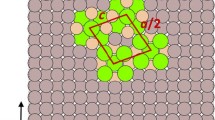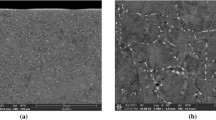Abstract
The fundamental processes controlling the high-temperature interaction of dislocations with precipitates in Al-alloys were investigated in real time by deforming specimens in situ in the transmission electron microscope at elevated temperature. The observations support a bypass mechanism involving the interaction of lattice dislocations with the precipitate–matrix interface dislocations, where the rate-limiting step in the interaction is the release of the dislocation from the particle. These observations are discussed in relation to high-temperature deformation processes and models.
Similar content being viewed by others
References
D. Hull and D.J. Bacon: Introduction to Dislocations, 4th ed. (Butterworth-Heinemann, Oxford, U.K., 2001), p. 222.
L.M. Brown and R.K. Ham: Dislocation–particle interactions, in Strengthening Methods in Crystals, edited by A. Kelly and R.B. Nicholson (Elsevier, New York, NY, 1971), pp. 985–135.
R. Lagneborg, and B. Bergman: The stress/creep rate behavior of precipitation-hardened alloys. Metal Sci. 10(1), 20 (1976).
E. Arzt and D.S. Wilkinson: Threshold stresses for dislocation climb over hard particles: The effect of an attractive interaction. Acta Metall. 34, 1893 (1986).
J. Rösler, and E. Arzt: A new model-based creep equation for dispersion strengthened materials. Acta Metall. Mater. 38, 671 (1990).
E. Arzt, G. Dehm, P. Gumbsch, O. Kraft, and D. Weiss: Interface controlled plasticity in metals: Dispersion hardening and thin film deformation. Prog. Mater. Sci. 46, 283 (2001).
R.S. Mishra, T.K. Nandy, and G.W. Greenwood: The threshold stress for creep controlled by dislocation-particle interaction. Philos. Mag. A 69, 1097 (1994).
L.M. Dougherty: Mechanisms operating during continuous dynamic recrystallization in an Al–4Mg–0.3Sc alloy, Ph.D. Thesis, University of Illinois, Urbana-Champaign (2003).
Properties and selection: Nonferrous alloys and pure metals, in ASM Metals Handbook, Vol. 2 (ASM, Metals Park, OH, 1979).
K. Fukunaga, and Y. Miura: Electron microscopic analysis of dislocation strucutres in l12-al3sc intermetallic compound. J. Jpn. Inst. Metals 62, 369 (1998).
S. Iwamura, M. Nakayama, and Y. Miura: Coherency between Al3Sc precipitate and the matrix in al alloys containing Sc. Mater. Sci, Forum 396–402, 1151 (2002).
R.W. Hyland, Jr. and R.C. Stiffler: Determination of the elastic constants of polycrystalline al3sc. Scripta Metall. Mater. 25, 473 (1991).
Y. Harada and D.C. Dunand: Thermal expansion of Al3Sc and Al3(Sc0.75X0.25). Scripta Mater. 48, 219 (2003).
W.B. Pearson: A Handbook of Lattice Spacings and Structures of Metals and Alloys, Vol. 2 (Pergamon Press, New York, 1967).
B. Reppich: On the attractive particle-dislocation interaction in dispersion-strengthened material. Acta Mater. 46, 61 (1998).
E.A. Marquis and D.C. Dunand: Model for creep threshold stress in precipitation-strengthened alloys with coherent particles. Scripta Mater. 47, 503 (2002).
D.V. Kudashov, U. Martin, M. Heilmaier, and H. Oettel: Creep behaviour of ultrafine-grained oxide dispersion strengthened copper prepared by cryomilling. Mater. Sci. Eng. A 387–389, 639 (2004).
M. Bartsch, A. Wasilkowska, A. Czyrska-Filemonowicz, and U. Messerschmidt: Dislocation dynamics in the oxide dispersion strengthened alloy incoloy MA956. Mater. Sci. Eng. A 272, 152 (1999).
D. Häussler, B. Reppich, M. Bartsch, and U. Messerschmidt: Interaction processes between dislocations and particles in the ODS nickel-base superalloy inconel ma 754 studied by means of in situ straining in an hvem. Mater. Sci. Eng. A 309–310, 500 (2001).
D. Häussler, M. Bartsch, U. Messerschmidt, and B. Reppich: HVTEM in situ observations of dislocation motion in the oxide dispersion strengthened superalloy MA754. Acta Mater. 49, 3647 (2001).
D.J. Srolovitz, R.A. Petkovic-Luton, and M.J. Luton: Diffusional relaxation of the dislocation-inclusion repulsion. Philos. Mag. A 48, 795 (1983).
Author information
Authors and Affiliations
Corresponding author
Additional information
This author was an editor of this focus issue during the review and decision stage. For the JMR policy on review and publication of manuscripts authored by editors, please refer to http://www.mrs.org/publications/jmr/policy.html.
Rights and permissions
About this article
Cite this article
Clark, B.G., Robertson, I.M., Dougherty, L.M. et al. High-temperature dislocation-precipitate interactions in Al alloys: An in situ transmission electron microscopy deformation study. Journal of Materials Research 20, 1792–1801 (2005). https://doi.org/10.1557/JMR.2005.0224
Received:
Accepted:
Published:
Issue Date:
DOI: https://doi.org/10.1557/JMR.2005.0224




